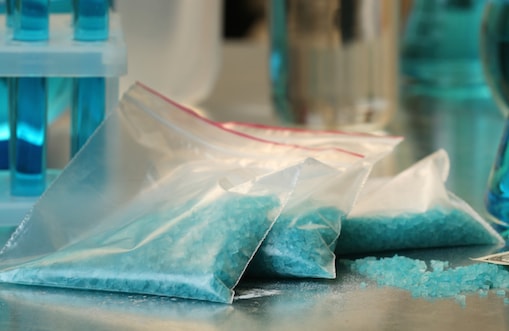Forget crack, heroin, and synthetic marijuana, bath salts are the new poster child of public fear over drugs. This family of chemicals, explored in-depth below, have been making some sensational headlines for several years now. The newest addition – Flakka – is just the tip of the bath salts iceberg.
What are they though? Chemically speaking, of course, but also on a more practical level. What are they doing to users? Should parents be as worried as the media says if they find bath salts in their kid’s room?
Read on to learn the answer to these questions and much more.
What are Bath Salts?
The first, and perhaps most obvious, myth surrounding these chemicals is that they’re actually used in baths. This isn’t even remotely true. The name bath salts was just an attempt by foreign manufactures to throw police off their trail.
Bath salts belong to a family of drugs known as synthetic cathinones. These are manmade versions of cathinones (better known by the name Khat). In addition to being powders produced in labs, rather than being leaves chewed for their mild psychoactive properties, synthetic cathinones are much stronger than their nature-found cousins.
While no one’s sure exactly how many different chemicals exist in the synthetic cathinone family – it doesn’t help that new ones are being synthesized frequently – it’s thought to number in the hundreds. Many of the more popular chemicals are now illegal (mephedrone for example), though dozens more are able to fly under the radar.

In terms of effect, bath salts are psychedelic stimulants that give users energy, euphoria, and pleasant hallucinations. They also produce a number of potentially harmful side effects, like paranoia, delusions, frightening hallucinations, aggression, and strength.
Synthetic cathinones are typically sold as powders and crystals. They’re often labelled as being used for cleaning, research, and other “not for human consumption” activities.
Common Synthetic Cathinones
Now that we know some basic information about what bath salts really are, let’s take a look at some of the most common types. Keep in mind that this list can be constantly updated as new analogues (very similar versions of an already existing chemical) are being created left and right.
Mephedrone is grandfather of all synthetic cathinones. First synthesized in the 1920s, it wasn’t used recreationally until the mid-2000s. It quickly gained popularity in Europe, Australia, and across Asia and Africa.
Mephedrone was outlawed just as quickly as it swept across these areas, with Israel and Sweden both making the substance illegal in 2008. Other countries followed soon after, including the European Union in 2010 and the US in 2011.
Speaking of America, MDVP and methylone were – and continue to be, albeit illegally – incredibly popular here. MDVP stands for Methylenedioxypyrovalerone, which is as dangerous as it is hard to pronounce. Methylone is almost chemically identical to MDMA, but with one extra group of molecules added.
Most recently, a-PVP has been making headlines. This chemical’s better known by its fear-inducing name – flakka.
Other popular synthetic cathinones include:
A Brief History of Synthetic Cathinones
We mentioned above that mephedrone was first created in the 1920s. It was synthesized and promprtly forgotten about for decades. Mephedrone and a handful of other synthetic cathinones were left to textbooks and research papers until the early 2000s.
It’s worth noting here that there’s some evidence to suggest bath salts were used as antidepressants in the 50s and 60s in the Soviet Union.

After being “rediscovered” in the 2000s, bath salts soon became popular as both stand alone drugs and as a cheap addition to ecstasy pills. Most countries were quick to outlaw them and their production shifted underground.
This brings us to today. From around 2012 on, most popular versions of bath salts are analogues of mephedrone, MDVP, and company. While these analogues are widely thought to be illegal in the United States (thanks to the 1986 Federal Analogue Act), the “not for human consumption” packaging is enough to push most into a legal gray area.
Are Bath Salts Really That Dangerous?
The short answer is yes, bath salts are absolutely that dangerous! With side effects ranging from high blood pressure to panic attacks to liver failure, these aren’t substances anyone should be touching.
It’s important to note that while synthetic cathinones are dangerous they’re not always the killer the media makes them out to be. Make no mistake, we’ve seen the harmful impact of bath salts first hand here at Malvern. We’ve treated patients struggling to get their lives and families back after abusing these drugs.
Still, they’re not the “one hit, instant addiction, deranged freakout” drugs sensationalized in headlines across the country. Bath salts are dangerous and, if addicted, require medical and clinical care to recover from. Rest assured, though, knowing that your loved one abusing synthetic cathinones isn’t a death sentence.
There’s hope and lots of it! That’s what we offer at Malvern Treatment Centers – the hope for a better, brighter, and sober tomorrow. Call us at 610-647-0330 today if you want that hope!
